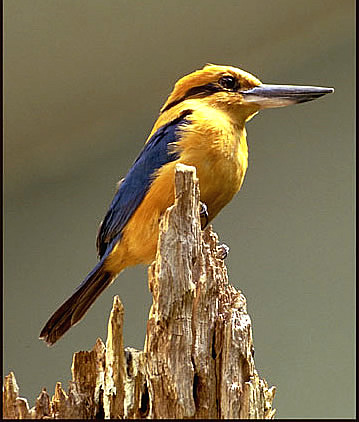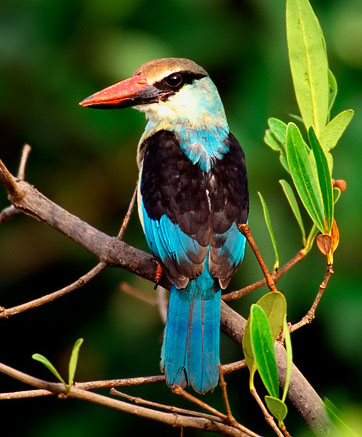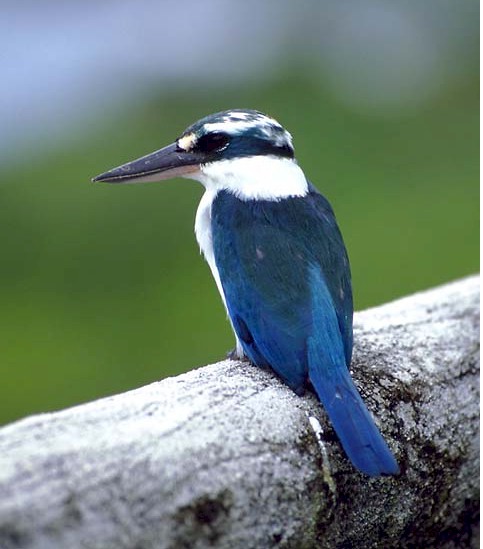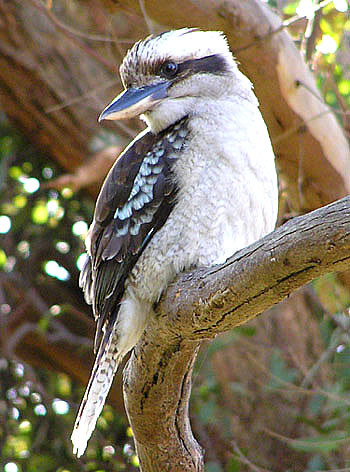Under Construction - 2 July 2006
 Guam
Micronesian Kingfisher (Halcyon c. cinnamomina)
Guam
Micronesian Kingfisher (Halcyon c. cinnamomina)
Taxonomy:
The Guam Micronesian kingfisher is one of three remaining subspecies of Halcyon cinnamomina. The other remaining subspecies are H. c. pelewinsis, which has a declining population on Palau island, but is not at this time considered to be threatened, and the subspecies with the highest population numbers, H. c. reichenbachii from Pohnpei. There was also H. c. miyakoensis, which has been considered to be extinct since 1887 when a single specimen was taken from S. Ryukyu Island.
General Information:
Previously, the Guam Micronesian kingfisher was considered to be a common and widespread resident of the island. The growth and development of the island along with the expansion of a U.S. airbase eliminated much of the resident forest and the habitat of the kingfisher. Along with the habitat decline, the accidental introduction of the brown tree snake caused significant drops in the population. By 1985, only ten pairs and ten solitary males were located and the only successful breeding on the island was in a snake-proofed location. In 1986, the remaining 29 birds were captured and all living birds are currently located in captive breeding programs.
Description:
Guam Micronesian kingfishers have a rufous crown, blackish-green mask extending around the nape, dark blue-green upperparts, purplish-blue wings, and cinnamon-rufous wing linings. In the females and juveniles the rufous body parts are pale in color. They are approximately 20cm (8 inches) in body length and approximately 58-74 grams in body weight.
Range and Habitat:
The range of the Micronesian kingfisher includes Pohnpei, Palau Islands, and formerly Guam and Miyako Jima. Micronesian kingfishers inhabit woods, forest, and marginal areas between natural woodland and country cleared for farming and settlement. In north Guam they lived in the remaining native forest on limstone soils and on mixed upland woods. They were found in wooded coastal lowlands among coconut palms, at the edges of mangrove swamps, and in spacious gardens.
Status:
The Guam Micronesian kingfisher is currently extinct in the wild and have an ongoing captive breeding program with the hopes of reintroduction to the island in the future.
Diet:
Consumes a diet consisting of large terrestrial insects and small vertebrates. These may include items such as grasshoppers, cicadas, skinks, and anoles. The Micronesian kingfisher perches on a low, exposed branch and waits for potential prey items, which are typically caught from the ground.
Breeding:
Both sexes work to excavate a cavity in a tall tree or coconut palm approximately three to eight meters above the ground in a tall tree or coconut palm. The pair may excavate many cavities within the territory, although only one will be utilized for nesting. The typical clutch size is two eggs, though infrequently as many as three eggs may be found in a clutch, which will be incubated for approximately 22 days. Both parents provide care for the offspring in the nest and after fledging in approximatley 32 days. The breeding season on Guam falls between December and July, while on Pohnpei breeding is typically in August.
Nestling development
Guam Micronesian Kingfisher Nestling Development Gallery
Guam Micronesian Kingfisher Chick Weight Gain (Captive Parent-reared)
Guam Micronesian Kingfisher Chick Weight Gain (Captive Hand-reared)
|
Genetic
Sample Collection Protocol
|
||
|
M.
avium Sample Collection Protocol
|
||
|
Pair
Introduction
|
||
|
Diet
Item Nutrient Ranges
|
||
|
Nutrient
Target Levels
|
||
|
Lizard
Feeding Protocols
|
||
|
Recommended
Diet
|
||
 Blue-breasted
Kingfisher (Halcyon malimbica)
Blue-breasted
Kingfisher (Halcyon malimbica)
General Information:
Description:
The blue-breasted kingfisher is the largest member of the genus Halcyon in Africa, measuring approximately ten inches (25cm) in length. The majority of the plumage is turquoise-blue with a black mask, back and shoulders. The crown is grey and the throat and abdomen are white. The upper mandible is bright red, while the lower mandible is black.
Range:
Habitat:
Blue-breasted kingfishers inhabit secondary forest, mangrove rainforest, dense woodlands growing along waterways in savanna country, and thick savanna woodlands dominated by Anogeissus leiocarpus trees. They prefer to remain in the deeply shaded areas in the lower canopies of trees, although they are irregularly seen in the high canopy.
Status:
Diet:
The majority of the diet consists of animal matter including invertebrates such as roaches, grasshoppers, termites, wasps, beetles, mantises, spiders, millipedes, whip-scorpions, crabs and molluscs. Mud-skippers, frogs, toads, lizards, and mice are also consumed. In addition, a highly sought after food by this and many other primarily carnivorous species (incuding some hawks and some insectivores) is the fruit of the oil-palm.
Reproduction:
Very few nests in the wild have been located and described, however those that have been are holes excavated into the sides of termitariums at a height of 6-10 meters. Four of these nests contained clutches and/or broods of two, however captive nests have yielded a maximum of five eggs with four eggs being regularly observed.
Captive Reproduction:
Blue-breasted kingfisher Nestling Development Gallery
Blue-breasted kingfisher Nestling Weight Gain Graph (Captive Parent-reared)
Blue-breasted kingfisher Nestling Weight Gain Graph (Captive Hand-reared)
Blue-breasted kingfisher Hand-rearing Information
Blue-breasted Kingfisher Gallery
 White-collared
Kingfisher (Todiramphus chloris)
White-collared
Kingfisher (Todiramphus chloris)
General Information:
White-collared kingfishers are a very widespread species with numerous subspecies. They are found on three continents (Australia, Asia, and Africa) and an extensive list of countries within those continents.
Description:
A fairly small primarily monomorphic kingfisher measuring around 23 to 26 cm (approximately 9-10 inches) in length and weighing 50-100 grams. The crown, sides of the head, mantle, scapulars, wings, back and tail are varying shades of blue to washed turquoise depending on the subspecies. The collar and underside are white. There is also a mottled white supercilium. The bill is primarily black with a pale yellow lower mandible. The juveniles are distinguised by a slight buffy-brown to the collar and a greenish hue to the upperparts.
Range:
The white-collared kingfisher range covers an enormous area, stretching from the Red Sea eastwards through India, Burma, Thailand, Malaysia, and Indonesia. The forty-nine subspecies can be found in eastern Africa, southeastern Asia, Australia, and an extensive number of the Austral-Asian islands.
Habitat:
In Ethiopia, Oman, and India they are found primarily in mangrove swamps. In southeast Asia they inhabit mangroves, creeks, beach-front vegetation, and plantations backing onto beaches. When there are no competing species of kingfishers present, white-collared kingfishers can be found inhabiting additional inland habitats.
Status:
Although the species in general is common and widespread, approximately forty of the known subspecies are found only on remote and small islands, including Erromanga, Torres, Pavuvu, Nissan, Duff, Malaita, Utupua, Rota, and many more (Howard and Moore 1991). Each of the islands is home to a unique form of the kingfisher, which due to their small and exposed populations are considered vulnerable to any environmental change, natural or man-made.
Diet:
Birds inhabiting coastal regions feed primarily on crabs, shrimp, and small fish. Those birds found further inland consume prey items such as earthworms, insects, snails, land crabs, spiders, frogs, small snakes, and uncommonly mice, bird eggs, and nestlings.
Breeding:
The breeding
season is from December until August, during which time the birds will
pursue each other in territorial courtship flights. The male courtship
feeds the female, often prior to a copulation attempt. In some cases,
the female may develop a bare spot at the nape resulting from multiple
copulation attempts. The nest holes, when excavated, are excavated by
both genders. The preferred nesting location is a rotten tree, stump,
or a earthen mound. Termitaria and holes previously excavated by woodpeckers
or barbets may also be utilized for nesting. The preferred height is extremely
variable, ranging from 2 to 30 meters above ground level, though nests
are typically less than 6 meters above ground. The clutch of eggs ranges
from 3-7 eggs, with each egg measuring between 27.8-31.1mm x 22.7-25.3mm.
The incubation lasts approximately 18 days and the chicks fledge from
the nest cavity at approximately 26 days of age.
White-collared Kingfisher Gallery
White-breasted Kingfisher (Halcyon smyrnensis)
General Information:
Description:
The head and underside are a deep chestnut coloration with a contrasting white throat and chest center. The tail, wings, median tail coverts, and back are blue. The white-throated kingfisher is approximately 27-28cm in total body length and ranges from 75-110 grams in weight.
Range:
Habitat:
This species has shown a high degree of adaptability and will utilize a variety of habitats. The preferred habitats are canals, swamps, bogs, dams, ponds, creeks, mudflats, and beaches, however they can also be found in countless agricultural areas, including palm plantations, rice fields, and general farmlands. In some areas they have even adapted to living in light industrial zones. With the exception of regions in Myanmar, the white-throated kingfisher entirely avoids the densely forested regions, instead remaining on the forest edges.
Status:
The white-throated kingfisher is generally considered common throught the majority of its range and may be locally abundant in some regions. The nesting density is found in some areas to be a distance of 100 meters distance between nests. The adaptability of the kingfisher has allowed it to increase its population in some areas during the course of the twentieth century. The birds have begun to make use of palm plantations and commercial agricultural regions not previously included in their preferred habitats.
Diet:
Wide variety of prey, including insects such as grasshoppers and crickets, earwigs, cockroaches, bugs, beetles, also crabs and crustaceans, earthworms, fish, frog and roads, lizards, snakes, small birds and rodents. Typical sit and wait predator, spends long periods on perch up to 10 m above ground (before diving head first or landing feet first), can hover for a moment over water before snatching prey.
Breeding:
Breeding
White-breasted
Kingfisher Gallery
 Laughing
Kookaburra (Dacelo novaguineae)
Laughing
Kookaburra (Dacelo novaguineae)
General Information:
Description:
The Laughing Kookaburra is about 17 inches (45 centimeters) long and is the largest member of the Kingfisher family. These birds have large bluntly flattened bills that end in a sharp point. The upper side of the bill is black and the underside is usually light brown. A heavy dark stripe extends through the eyes. Laughing Kookaburras are predominantly brown, though the head and undersides are grayish white. The crown is usually brown. The male Laughing Kookaburra has blue feathers at the top of his tail, while the female's tail is colored with brown feathers. Males also have blue wing patches, whereas the female's are gray. Laughing Kookaburras do not have separated toes; rather, the toes at the middle and the outside are fused.
Range
Laughing Kookaburras make their homes in Eastern and Southwestern Australia. At the time of the arrival of European settlers, the natural range was eastern Australia from Cape York Peninsula, east and west of the Great Dividing Range, to Victoria, west to Flinders Range and Cape Otway. Multiple introduction attempts eventually led to the birds successfully colonizing the southwest first in 1897, then Tasmania in about 1905, Kangaroo Island in 1926 and finally Flinders Island in 1940. Several attempts were made to introduce the birds to New Zealand between 1866 and 1880, though they only survive in small sections.
Habitat
Open, dry eucalypt forest, woodland, wooded farmland, and watercourses, homesteads, city parks, and gardens.
Diet:
Kookaburras are predacious birds consuming a large variety and vertebrate and invertebrate prey items including snakes, lizards, frogs, fish, adult and nestling birds, and insects. The majority of the food acquired is caught from the ground with a small amount being taken from shallow waters.
Status:
Estimates of density in New South Wales and Victoria vary from 0.05 to 0.8 individuals per hectare. Using the average density of birds and extrapolating out the values to cover the available habitat, this would yield an approximate population of 66.5 million birds.
Vocalization:
The laughing vocalization delivered by the kookaburra is a territorial call delivered by two or more birds simultaneously. This call is typically given at dusk and dawn and lasts at least 6-8 seconds. A video of the Laughing Kookaburra vocalization can be seen by clicking here (Kookaburra.MOV 4.87mb). Video courtesy of Natural Encounters, Inc.
Breeding:
Pairs of Laughing Kookaburras remain together for life, which in the wild can be at least 10-12 years. Courtship behaviors are not very elaborate and consist of the male beginning to feed the female approximately six weeks prior to the onset of egg-laying. The courtship feeding increases in frequency as the egg lay date approaches and then ends roughly three days after the clutch is complete. The egg-laying season in southeast Australia is between September and December.
Laughing
Kookaburras reach sexual maturity at one year of age. They usually nest
in a tree cavity, but have also been known to use holes in the walls of
human-made structures or even termites' nests. Between two and three white
eggs are deposited and incubated for between 18 and 22 days. Both parents
are involved in this, as in all, chick-rearing processes. Between 20 and
30 days after they hatch, the young Laughing Kookaburras will fledge.
They remain with their parents for some time, often aiding in the incubation
of other broods. Although some leave earlier, many Laughing Kookaburras
stay with their parents for up to four years before taking a mate.
Laughing Kookaburra Gallery
General Information:
Description:
A very large member of the kingfisher family measuring 38-41cm in body length and weighing between 250-322 grams for males and 260-370 grams for females.
Range:
Habitat:
Savannah woodland, eucalypt woodland and forest, tall trees and woodland along watercourses, mangrove and monsoon forests. Blue-winged Kookaburra typically avoid areas of the forest with dense understories.
Status:
Blue-winged Kookaburra are not globally threatened. They are considered to be fairly common across the majority of their range, even though some suitable habitat is being clear-cut to make way for agriculture. Their range is extending in New Guinea even with forest clearing.
Diet:
Wide variety of vertebrates and invertebrates including grasshoppers, crickets, mantids, beetles, cicadas, bees, wasps, millipedes, crabs, crayfish, fish, frogs, lizards, snakes and small birds.
Breeding:
Breeding is in either pairs or small groups of birds typically numbering no greater than twelve birds. The breeding group normally is composed of three birds, the breeding pair and one offspring from the previous year. This auxilliary bird assists with nest construction, territory defense, incubation, brooding, and feeding the offspring. The nest site is excavated by both genders and may be located in termite mounds or tree cavities. The clutch size averages two eggs, although larger clutches have been recorded and may be the result of mulitple females laying eggs in the same nest. The eggs are incubated for approximately 24-26 days, and the chicks will fledge from the nest in an additional 36-39 days. Independance from the parents may be as early as 60 days, though some chicks take as long as 4-6 months.
Movements:
Blue-winged Kookaburra are generally considered to be sedentary in nature, often staying within the same territory for many years consecutively. Their movement is generally considered to be nothing more than a shift between differing habitats of the same territory.
Blue-winged Kookaburra Gallery
Pied Kingfisher ()
General Information:
Description:
Range:
Habitat:
Status:
Diet:
Breeding:
Pied Kingfisher Gallery